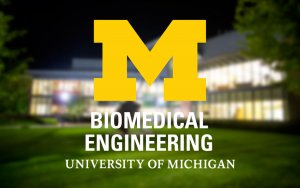Presented By: Biomedical Engineering
Acoustical Methods for Cavitation Control in Shockwave Lithotripsy and Histotripsy
Hedieh Alavi Tamaddoni - Final Oral Examination

The overall goal of the work presented in this dissertation is to develop acoustic mechanisms to modulate, or manipulate, cavitation events in histotripsy and lithotripsy therapies in order to achieve efficient and fast histotripsy, high shock rate lithotripsy, and active tissue protection. We investigated the effects of applying properly tuned low pressure acoustic pulses before and during therapy in order to control the cavitation threshold, the shape of the resulting bubble cloud, and the behavior and interactions of residual microbubbles.
Histotripsy is a tissue ablation method that utilizes focused high amplitude ultrasound to generate a cavitation bubble cloud that mechanically fractionates tissue. Effective histotripsy depends on initiation, control, and maintenance of cavitation bubble clouds in the targeted area. The work in this dissertation seeks to develop active tissue protection techniques by modulating the pressure threshold of bubble cloud initiation and focal sharpening using bubble suppressing pulses. We demonstrated that by applying a properly tuned low pressure pulse sequence before and/or during shock scattering histotripsy therapy, both the cavitation initiation pressure threshold and the growth of the cavitation bubble can be modified. This mechanism can be used to produce well defined lesions with minimal collateral damage. It can also be a way to actively protect soft tissue from cavitation damage during both lithotripsy and histotripsy by increasing the pressure threshold for bubble cloud initiation in the periphery zone.
Cavitation also plays a significant role in the efficacy of stone comminution during shockwave lithotripsy (SWL). Although cavitation on the surface of urinary stones helps to improve stone fragmentation, cavitation bubbles along the propagation path may shield or block subsequent shockwaves and potentially induce collateral tissue damage. At low firing rates, there is sufficient time for the majority of the bubbles to passively dissolve, while at high firing rates the per shockwave efficacy is significantly reduced due to pre-focal persisting bubbles. We investigated acoustic methods for removing residual bubble nuclei in order to avoid shielding effects. Previous in vitro work has shown that applying low amplitude acoustic waves after each shockwave can force bubbles to consolidate and enhance SWL efficacy. In this work, the feasibility of applying acoustic bubble coalescence (ABC) in vivo was examined. We further optimized the parameters of bubble coalescing pulses, and conducted a feasibility investigation of bubble dispersion by forcing the residual bubble nuclei to disperse from the propagation path away or toward the targeted area before the arrival of the next therapy pulse. These results suggest that manipulation of residual bubbles after each shockwave can be further optimized by acoustic bubble coalescence and dispersion, which can reduce the shielding effect of residual bubble nuclei more efficiently than relying only on immediate coalescence of residual bubbles, resulting in a more efficient SWL treatment.
Histotripsy is a tissue ablation method that utilizes focused high amplitude ultrasound to generate a cavitation bubble cloud that mechanically fractionates tissue. Effective histotripsy depends on initiation, control, and maintenance of cavitation bubble clouds in the targeted area. The work in this dissertation seeks to develop active tissue protection techniques by modulating the pressure threshold of bubble cloud initiation and focal sharpening using bubble suppressing pulses. We demonstrated that by applying a properly tuned low pressure pulse sequence before and/or during shock scattering histotripsy therapy, both the cavitation initiation pressure threshold and the growth of the cavitation bubble can be modified. This mechanism can be used to produce well defined lesions with minimal collateral damage. It can also be a way to actively protect soft tissue from cavitation damage during both lithotripsy and histotripsy by increasing the pressure threshold for bubble cloud initiation in the periphery zone.
Cavitation also plays a significant role in the efficacy of stone comminution during shockwave lithotripsy (SWL). Although cavitation on the surface of urinary stones helps to improve stone fragmentation, cavitation bubbles along the propagation path may shield or block subsequent shockwaves and potentially induce collateral tissue damage. At low firing rates, there is sufficient time for the majority of the bubbles to passively dissolve, while at high firing rates the per shockwave efficacy is significantly reduced due to pre-focal persisting bubbles. We investigated acoustic methods for removing residual bubble nuclei in order to avoid shielding effects. Previous in vitro work has shown that applying low amplitude acoustic waves after each shockwave can force bubbles to consolidate and enhance SWL efficacy. In this work, the feasibility of applying acoustic bubble coalescence (ABC) in vivo was examined. We further optimized the parameters of bubble coalescing pulses, and conducted a feasibility investigation of bubble dispersion by forcing the residual bubble nuclei to disperse from the propagation path away or toward the targeted area before the arrival of the next therapy pulse. These results suggest that manipulation of residual bubbles after each shockwave can be further optimized by acoustic bubble coalescence and dispersion, which can reduce the shielding effect of residual bubble nuclei more efficiently than relying only on immediate coalescence of residual bubbles, resulting in a more efficient SWL treatment.
Explore Similar Events
-
Loading Similar Events...
